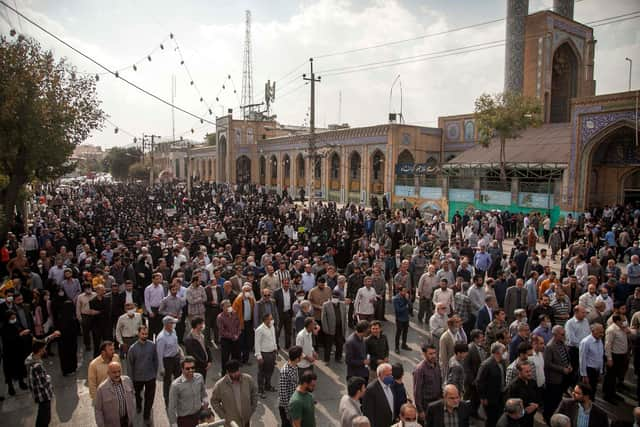Iranian protesters in fresh confrontation with police in south-east city
The nationwide protests after the woman’s death in September, after she is alleged to have been detained after violating the Islamic Republic’s strict dress code, have raged across Iran, involving more than 125 areas.
At least 270 people have been killed and nearly 14,000 have been arrested, according to the group Human Rights Activists in Iran.
Advertisement
Hide AdAdvertisement
Hide AdThey have also expanded beyond protests over Iran’s mandatory headscarf, or hijab, for women, and taken in rallies against Iran’s clerical system.


Activists estimate that in Zahedan alone, nearly 100 people have been killed since a rally there on September 30 set off a violent police response.
The demonstrations have become the greatest threat to the country’s theocratic government since the 2009 Green Movement demonstrations.
Women continue to remove their hijabs during the street protests as international pressure grows on Iran’s government over its crackdown on demonstrators.
Videos of the protests on Friday in Zahedan around the city’s Makki Grand Mosque purportedly included the sound of gunfire.
Later footage showed streaks of blood on tilework and bloody palm prints in the mosque’s courtyard, with activists saying they feared two people had been killed.
Iranian authorities did not immediately acknowledge Friday’s violence in Zahedan, a city in Iran’s Sistan and Baluchistan province that is located about 310 miles south-east of the the country’s capital, Tehran.
However, the state-run IRNA news agency carried a statement by the province’s security council earlier Friday saying that the police chief in Zahedan and another police official have been sacked over their handling of the September 30 protest.
Advertisement
Hide AdAdvertisement
Hide AdThe statement for the first time acknowledged that police shot and killed people praying at the time at a nearby mosque.
The security council’s version of the demonstration alleged that 150 people, including armed men, attacked a police station and attempted to take it over during the protests.
The “armed conflict, and police shooting, unfortunately, led to the wounding and killing of a number of worshippers and innocent passers-by who had no role in the unrest”, the statement said.
However, the statement claimed that only 35 people were killed, while activists estimate about three times that number were killed by security forces, who also allegedly fired on protesters from helicopters.
New protests took place in other cities as well, including in western Baneh, on Thursday night.
Activists warned others had been killed by security forces. However, Iran’s government has not provided an overall death toll from the protests in weeks.
Gathering information about the demonstrations remains difficult. Internet access has been disrupted for weeks by the Iranian government. Meanwhile, authorities have detained at least 46 journalists, according to the Committee to Protect Journalists.
Iranian officials, including Supreme Leader Ayatollah Ali Khamenei, have repeatedly alleged the country’s foreign enemies are behind the ongoing demonstrations, rather than Iranians angered by Ms Amini’s death and the country’s other woes.
Iranians have seen their life savings evaporate as the country’s currency, the rial, plummeted, while Tehran’s nuclear deal with world powers has been reduced to tatters.